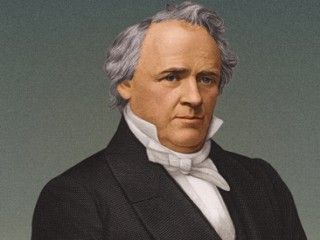
James Buchanan biography
Date of birth : 1791-04-23
Date of death : 1868-06-01
Birthplace : Lancaster, Pennsylvania, United States
Nationality : American
Category : Politics
Last modified : 2010-10-05
Credited as : Politician, former U.S. President,
1 votes so far
James Buchanan was born on April 23, 1791, on a farm in Lancaster, Pa., the son of a Scotch-Irish immigrant. After graduating from Dickinson College in 1809, Buchanan became a lawyer. As a Federalist, he was elected to the Pennsylvania Assembly in 1814 and to the U.S. House of Representatives in 1820. He was an early supporter of Andrew Jackson's presidential aspirations and became a leading member of the new Democratic party in Pennsylvania. Buchanan was elected to the U.S. Senate in 1834, serving there until 1845. As a senator, he supported Southern demands that all abolitionist petitions to the Senate be immediately tabled without consideration.
Presidential Contender
At the 1844 Democratic convention, Buchanan was one of the leading contenders for the presidential nomination but lost out to James K. Polk. When Polk won the presidency and formed his Cabinet, Buchanan was named secretary of state. In this position he played a key role in Polk's expansionist policies. He successfully negotiated a treaty with England over the Oregon Territory, thus avoiding a possible war. At the beginning of the administration, he often acted as a moderating influence on the President, but later Buchanan became a leading imperialist. He urged rejection of the Treaty of Guadalupe Hidalgo (1848) in favor of annexation of large areas of Mexico. He also tried to secure the purchase of Cuba from Spain for $120 million.
At the 1848 and 1852 Democratic conventions, Buchanan was a leading contender for the presidential nomination but was again passed over. In 1853, he was appointed ambassador to England by President Franklin Pierce. While on this mission, in order to win Southern support for his nomination in 1856 he helped draft the Ostend Manifesto, which called for United States acquisition of Cuba, by force of arms if necessary. Returning to the United States in 1856, he received the Democratic nomination for president, and won the election.
A Crisis President
Buchanan sought to restore unity within his party and within the country by appointing Democrats from all geographical sections to the Cabinet. He was doomed to failure. A week after he was inaugurated, the Supreme Court handed down the Dred Scott decision, which upheld the Southern position that Congress had no right to legislate on the question of slavery in the territories. The decision alienated a great many Northerners.
Another stumbling block of Buchanan's administration was the constitution submitted by the territory of Kansas to Congress. A proslavery convention had drawn up the Lecompton Constitution. Governor Robert Walker warned that unless the whole document was submitted for a vote, Congress would reject it. In defiance of the threat, only one section of the constitution was submitted. Buchanan put great pressure on Congress to accept it and to admit Kansas as a state but ran into opposition from Stephen A. Douglas, his party's most powerful senator. Douglas argued that the document was fraudulent and violated the provisions of the Kansas-Nebraska Act, which had provided for popular sovereignty. This dispute split the Northern and Southern wings of the Democratic party.
Buchanan's handling of the Kansas problem was complicated by several other difficulties. Shortly after he had taken office, the country went into a depression. Adhering to a strict states'-rights doctrine, Buchanan cut the budget and urged stricter regulation of banks but refused to commit the Federal government to relief measures. He also had difficulty with the Mormons, who had settled in the Utah Territory. As a consequence of Brigham Young's refusal to accept a governor appointed in Washington, the President sent 2,500 troops to bring Utah under Federal control. After the Mormons fled Salt Lake City and threatened a scorched-earth policy, Buchanan reached a compromise with Young that granted the Mormons a high degree of autonomy.
The administration also failed to achieve its diplomatic goals, which were to repudiate the Clayton-Bulwer Treaty and to establish American control over Central American and Cuba. In his last year and a half of the presidency, Buchanan faced a hostile Republican majority in Congress and had no hopes of securing ratification of a treaty on either subject, even had one been negotiated.
By the time of the Democratic convention in April 1860, the administration had been completely repudiated. The Democratic party broke into two factions--the North supporting Douglas for president and the South supporting Vice President John C. Breckinridge of Kentucky.
When Lincoln won in November 1860, Buchanan faced his final crisis--the secession of South Carolina. Unable to secure support in Congress and unable to overcome his own scruples against the use of force to restore the Union, Buchanan found his administration paralyzed. This paralysis was compounded by Lincoln's refusal to agree to any policy before actually becoming president. Buchanan did support efforts to conciliate the two sides, especially the Crittenden Compromise and the Peace Conference called by Virginia in 1861, but when these failed, so did the Union. Many Northerners blamed him for the dissolution of the Union and the ensuing Civil War. Thus, as the new president took office, Buchanan left Washington, a bitter and tired old man. He returned to Lancaster, where he died on June 1, 1868, at the age of 77.
















